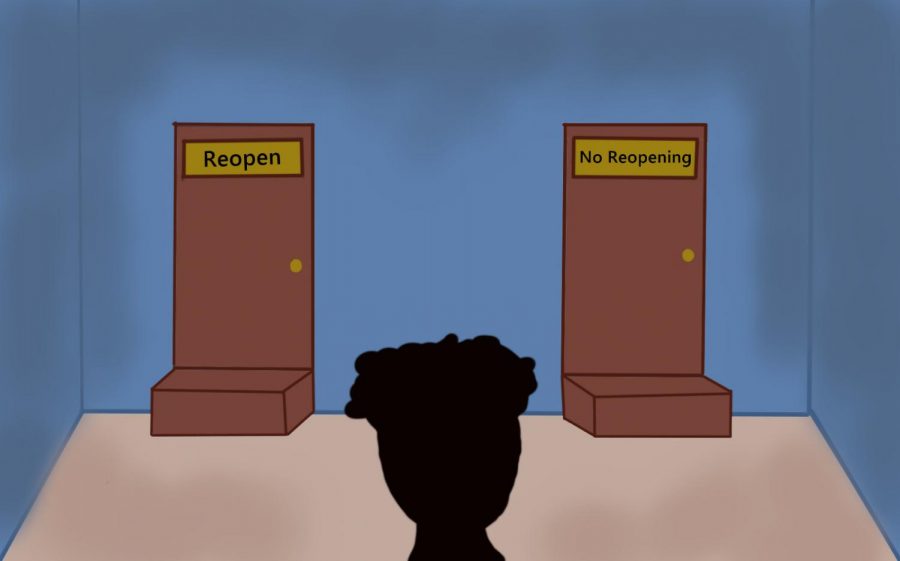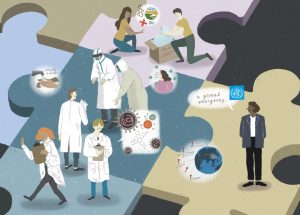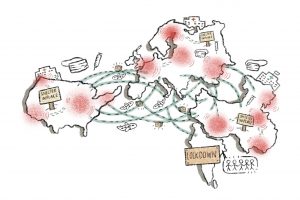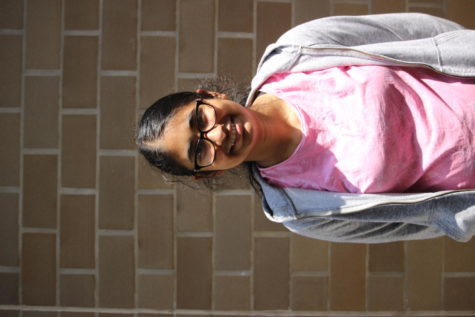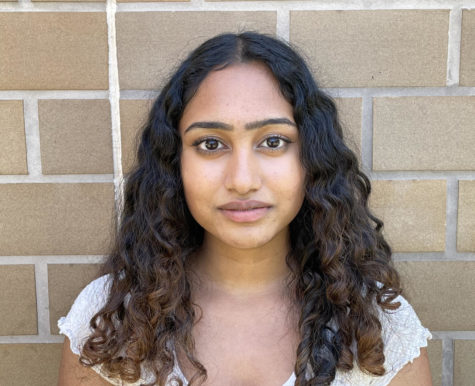Reopening the economy proves to be a bad idea
As coronavirus cases decrease throughout California, officials are left with a choice: to reopen or not to reopen? Lives are at stake in whatever choice they make.
October 20, 2020
Reopening during times of COVID-19 means lifting social distancing restrictions and allowing businesses to begin accepting in-person customers again, according to NPR. This definition of reopening can be applied to all aspects of our society, from schools to shops to movie theaters. On Sept. 29, Contra Costa County qualified to move into the “red” tier of California’s four tiered, color coded reopening system. This move into the red zone allowed the county to reopen some non-essential indoor businesses. While this transition is accompanied with dwindling case numbers, reopening the economy, in terms of restaurants, all other indoor businesses and schools, is not the best option right now. There doesn’t need to be a rush to reopen.
Currently, there are 6.2 cases per 100k residents in the county. Dr. Chris Farnitano, the county health officer, attributes the decrease in cases “to the residents of Contra Costa, who have adapted to the new normal and modified their lifestyles to reduce the spread of COVID in the county.” If this is the case, then the reopening of the economy should cause an increase in cases, bringing the county back to square one.
This has been seen in places which have already reopened. Earlier in the summer, California reopened for a month but then promptly closed down again after cases surged.
While reopening might seem like the best idea to help the economy, the health risk isn’t worth it. According to Tim Parsons, an economist at Johns Hopkins, reopening will bring some relief to workers, but not enough for them to go back to normal completely, especially since some people will be more cautious about eating out during a global pandemic. With the popularization of food delivery services, it may not even be completely necessary to do so. And, while many places have decided to reopen outside as opposed to indoors (since the virus spreads less in outdoor settings), doing so is still unsafe and has led to an increase in case numbers. Just because something has reopened doesn’t mean that it’s safe to go there, as many external pressures could have led to the reopening.
“If your favorite watering hole reopens, that’s not a guarantee that it’s safe to go have a beer with your friend,” Andrew Noymer, a public-health professor at UC Irvine, said. “That’s one possible reason that it’s reopening, but another is that the pressures to reopen businesses have been so enormous, adding on to say that if the U.S. was solely concerned with containing the virus, “reopening shouldn’t even be in the conversation yet.”
School districts have also been pressured to reopen sooner than they should by the United States government. In July, President Donald Trump threatened to cut funding to schools that did not reopen. Vice President Mike Pence also said that CDC guidelines should not be a reason for schools to stay closed. Additionally, schools have also felt pressures to reopen from parents, which resulted in some California parents suing Governor Gavin Newsom to force schools to reopen for in-person learning. Amidst these comments and actions made by the executive branch and by some parents, it’s no surprise that many school districts, including SRVUSD, have felt the pressure to reopen as soon as possible.
The SRVUSD district has confirmed a hybrid learning model that will be implemented for Jan. 5, 2021. In this model, students will return to school for half of the week, and learn remotely for the other half. The desks are supposed to be spread out according to CDC guidelines, with no lunch time and less than 15 kids per class. While this is enough according to some people, it is unclear what has caused the rush to return back to school. Hybrid also introduces the health risk aspect, as students will likely not perfectly social distance with each other, and the way the proposed sanitation between classes is supposed to take place is unclear. Teachers are also at higher risk, since they have to stay in the classrooms for the whole week, even during the hybrid schedule. Online is much safer for all parties involved (students, parents, teachers, etc.) as it most effectively prevents further spreading of COVID-19.
However, there are some downsides to virtual learning. Opening schools is important for some students, such as students with special needs. These are different cases, however, and certain measures will be put into place for them, such as there not being any more than five students per class. The problem doesn’t arise there, but rather from the claim that it is safe to reopen schools for all general education students.
Additionally, some people dislike how much screen time virtual learning entails. An article from the Atlantic says, “Not all students have internet access, so poor kids are falling behind. Even if they can get online, having a 7-year-old stare at a computer all day is generally not seen as advisable by child-development experts.” While virtual learning does have its downsides as mentioned, the health risks of its alternatives as mentioned earlier far outweigh the negatives of virtual learning. Learning online comes with its challenges for everybody, but teachers and their students are able to manage it together, safely at home, without the added risk of in-person hybrid learning.
Just because things have reopened doesn’t mean that it’s safe to return to normalcy. While you may miss going outside to a restaurant with your friends, throwing parties, or talking to your friends in school, it is still unsafe to return to normal life. On average, case numbers are continuing to rise all across the country with these new reopening practices, according to the Washington Post. Case numbers decreased during the spring and early summer when everything was closed due-to a stay-at-home order. With case numbers continuing to rise, it’s imperative that even if things do not close down, people stay home.
“Reopening does not mean we all get to be close together again, as hard as that is,” Elizabeth Carlton, a professor at the Colorado School of Public Health, said.

